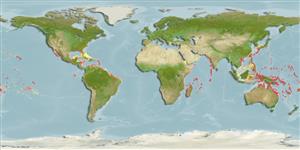Trichoplax adhaerens Schulze, 1883
| Native range | All suitable habitat | Point map | Year 2050 |

|
| This map was computer-generated and has not yet been reviewed. |
| Trichoplax adhaerens AquaMaps Data sources: GBIF OBIS |
Uploaden van je Foto's
Google afbeelding |
No photo available for this species.No drawings available for Trichoplacidae.
Google afbeelding |
No photo available for this species.
Classification / Names Common names | Synonyms | CoL | ITIS | WoRMS
| Not assigned | Trichoplacidae
Environment: milieu / climate zone / depth range / distribution range Ecologie
. Tropical
Verspreiding Landen | FAO regio's | Ecosystems | Voorkomen | Introducties
Circumglobal.
Length at first maturity / Size / Gewicht / Leeftijd
Maturity: Lm ? range ? - ? cm
Korte beschrijving Morfologie
Flat (up to 0.5mm in its longest dimension), multicellular, amorphous, mobile flagellated animal lacking body cavity, digestive and nervous systems, composed of 2 layers of epithelial cells. Associated glandular cells apparently secrete digestive enzymes beneath the animal as it sits atop the algae and protozoans on which it apparently feeds; digestion seems to be entirely extracellular , as there is no mouth and no sign of phagocytosis. The much thinner, upper layer of the animal bears flagellated cells, but no gland cells. In a sense, the upper layer is ectodermal, while the lower layer, because of its involvement in digesting food and absorbing nutrients, is endodermal. Between the upper and lower cell layers is a fluid-filled space containing a dense network of fibrous cells that may be contractile (Ref. 53).
Commonly found in warm marine environments (Ref. 57) and in marine aquaria (Ref. 59), on hard bottom substrates in the benthic regions (Ref. 53). A scavenger which feeds on dead animals with its ventral surface, which produces digestive enzymes (Ref. 53), and also feeds on Cryptomonas (Ref. 57 and 60) and algae (Ref. 59); often, individuals contract part of the ventral surface into a sac where digestion may take place more efficiently (Ref. 60).
Life cycle and mating behavior Geslachtsrijpheid | Voortplanting | Kuitschieten | Eieren | Fecundity | Larven
Reproduces asexually, binary fission, budding (Ref. 60), fragmentation (Ref. 53). Older cultures at high density begin to produce small motile presumptive sperm cells, and as individual animals disintegrate, they spew out ova (Refs. 59, 61).
Voornaamste referentie
Referenties | Coördinator | Medewerkers
Collins, A.G. 2000. (Ref. 60)
Status op de Rode Lijst van het IUCN (Ref. 130435)
Status bij CITES (Ref. 108899)
Not Evaluated
CMS (Ref. 116361)
Not Evaluated
Gevaarlijk voor mensen
Harmless
Gebruik door de mens
| FishSource |
Tools
Meer informatie
Populaire namen
Synoniemen
Predators
Voortplanting
Geslachtsrijpheid
Kuitschieten
Fecundity
Eieren
Ontwikkeling van de eieren
Synoniemen
Predators
Voortplanting
Geslachtsrijpheid
Kuitschieten
Fecundity
Eieren
Ontwikkeling van de eieren
Internet-bronnen
BHL | BOLD Systems | CISTI | DiscoverLife | FAO(Publication : search) | Fishipedia | GenBank (genoom, nucleotide) | GloBI | Gomexsi | Google Books | Google Scholar | Google | PubMed | Tree of Life | Wikipedia (ga naar, zoek) | Zoological Record
Estimates based on models
Prijsklasse
(Ref. 80766):
Unknown.


